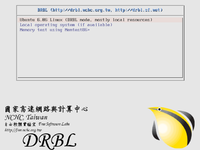- Diskless Remote Boot in Linux
-
DRBL 

Graphical boot menu of DRBL.Developer(s) NCHC Free Software Labs Initial release April 1, 2004 Stable release 1.9.9-21[1] / April 5, 2011 Development status Active Operating system Linux Type Disk cloning, Disaster recovery, Network boot, PXE boot License GNU General Public License Website drbl.org DRBL (Diskless Remote Boot in Linux) is a NFS-/NIS server providing a diskless or systemless environment for client machines.
It could be used for
- cloning machines with Clonezilla software inbuilt,
- providing for a network installation of Linux distributions like Fedora, Debian, etc.,
- providing machines via PXE boot (or similar means) with a small size operation system (e. g. DSL, Puppy Linux, FreeDOS).
Providing a DRBL-Server
- Installation on a machine running a supported Linux distribution via installation script,
- Live CD.
Installation is possible on a machine with Debian, Ubuntu, Mandriva, Red Hat Linux, Fedora, CentOS or SuSE already installed. Unlike LTSP, it uses distributed hardware resources and makes it possible for clients to fully access local hardware, thus making it feasible to use server machines with less power. It also includes Clonezilla, a partitioning and disk cloning utility similar to Symantec Ghost.
DRBL comes under the terms of a GPL license so providing the user with the ability to customize it.
Contents
Features
DRBL excels in two main categories.
Disk Cloning
Clonezilla (packaged with DRBL) uses partimage to avoid copying free space, and gzip to compress Hard Disk images. The stored image can then be restored to multiple machines simultaneously using Multicast packets, thus greatly reducing the time it takes to image large numbers of computers. The DRBL Live CD allows you to do all of this without actually installing anything on any of the machines, by simply booting one machine (the server) from the CD, and PXE booting the rest of the machines.
Hybrid Client
An excellent way to make use of old hardware. Using old hardware as Thin Clients is a good solution, but has some disadvantages that a Hybrid Client can make up for.
- Streaming Audio/Video - A Terminal Server must decompress, recompress, and send video over the network to the client. A Hybrid does all decompression locally, and can make use of any graphics hardware capabilities on the local machine.
- Software that requires real-time input - Since all input at a thin client is sent over the network before it is registered by the operating system, there can be substantial delay. This is a major problem in software that requires real-time input (i.e. video games). Hybrid clients run the software locally, and as such, do not have this problem.
DRBL allows you to set up multiple Hybrid Clients with relative ease.
How it works
The client computer is set to boot from the network card using PXE or Etherboot. The client requests an IP address, and tftp image to boot from, both are provided by the DRBL server. The client boots the initial RAM disk provided by the DRBL server via tftp, and proceeds to map an nfs share (also provided by the DRBL server) as its root (/) partition. From there, the client boots either the linux distribution on which the DRBL server is installed, Clonezilla, or an installer for various Linux distributions, depending on how that particular client was configured on the DRBL server.
All system resources reside on the local machine except storage, which resides on the DRBL server.
Keys to a successful Hybrid Client environment with DRBL
The main chokepoint in a DRBL installation is between the storage on the DRBL server, and the client workstation. Fast storage on the server (RAID), and a fast network (Gigabit Ethernet), are ideal in this type of environment.
External resources
References
Linux operating system Linux Adoption (Adopters) · Criticism (of desktop Linux) · History · Kernel (kernel names · supported architectures) · Linus' Law · Linux Foundation · Linux-libre · Tux · vmlinux
Distribution GNU Free Software Foundation · GNU · GNU GPL · GNU/Linux naming controversy · GNU packages · GNU ProjectWindow manager User interface Applications People Media Lists System arrangement
and featuresMobile Access Linux Platform · Android · Ångström · bada · LiMo Foundation · LiMo Platform · Linux Phone Standards Forum · MeeGo (Maemo · Moblin) · Mobilinux · Open Handset Alliance · Openmoko · OPhone · webOS · SHR · Ubuntu MobileOther topics Linux conference · Linux Documentation Project · Malware · Linux Standard Base · Linux User Group (LUG) · Revolution OS · SCO and Linux · Tanenbaum–Torvalds debate · The CodeCategories:
Wikimedia Foundation. 2010.
